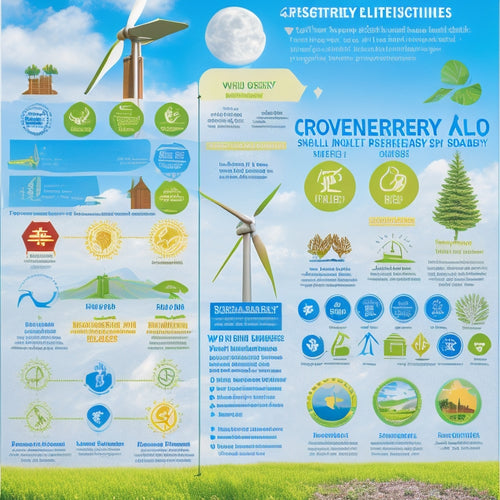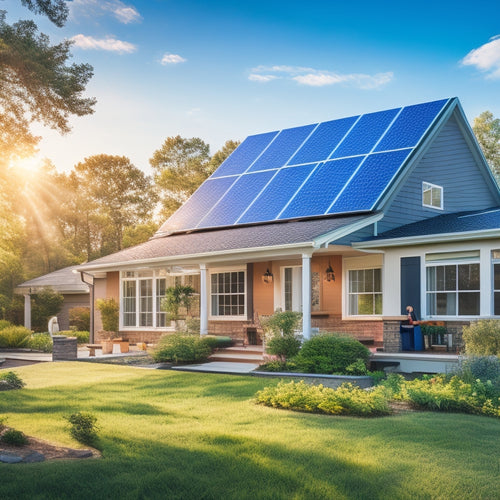
Solar Power System Installation Costs to Consider
Share
When considering solar power system installation costs, you'll want to factor in multiple components. hardware and equipment costs vary depending on the type and quality of solar panels, inverters, mounting systems, and monitoring systems you choose. Labor and permit fees can add up quickly, with experienced installers providing detailed breakdowns. Roofing and mounting expenses are influenced by roof type complexity, and ongoing maintenance costs include scheduled inspections, component replacement, and software upgrades. As you weigh these expenses, it's crucial to prioritize energy efficiency and thorough planning to maximize your investment. Understanding these costs is just the beginning of optimizing your solar power system.
Key Takeaways
- Prioritize energy-efficient hardware selection to maximize return on investment, considering factors like panel type and inverter efficiency.
- Labor costs vary by installation complexity, location, and installer proficiency, accounting for a substantial portion of overall installation costs.
- Roof type and complexity impact installation costs, with simple gable roofs being the least expensive and slate/clay tile roofs being the most expensive.
- Permit fees range from $500 to $2,000+, and local inspection requirements can add to overall costs and timelines.
- Ongoing maintenance expenses include scheduled inspections, component replacement, troubleshooting, software upgrades, and service contracts to ensure optimal system performance.
System Hardware and Equipment Costs
Your solar power system's backbone consists of the hardware and equipment that convert sunlight into electricity. These components greatly impact your system's overall performance and energy efficiency.
The type of solar panels you choose plays an important role in determining your system's energy output. There are two primary solar panel types: monocrystalline and polycrystalline. Monocrystalline panels are more efficient but also more expensive, while polycrystalline panels are less efficient but more affordable.
In addition to solar panels, you'll need an inverter to convert DC power into AC power, which is usable in your home. Inverters vary in efficiency, with high-efficiency models being more expensive.
Mounting systems, which secure your solar panels to your roof, also affect your system's energy efficiency. Look for mounting systems with a high degree of adjustability to guarantee the best panel angle and orientation.
Other vital hardware and equipment include monitoring systems, which track your system's performance, and electrical connections, which guarantee safe and efficient energy transmission.
When selecting your system's hardware and equipment, prioritize energy efficiency to maximize your return on investment.
Installation Labor and Permits
When installing a solar power system, you'll need to take into account the labor costs associated with the project, which can vary depending on the complexity of the installation, the location, and the installer's proficiency.
Permit fees are another key aspect to factor in, as they can differ considerably depending on the jurisdiction and type of installation.
You'll need to understand the local inspection requirements and permit fee structures to accurately estimate these costs.
Labor Cost Breakdown
Installing a solar power system requires vital labor efforts, which account for a substantial portion of the overall cost. As you evaluate the installation of a solar power system, it's important to understand the labor cost breakdown.
The labor cost is influenced by various factors, including the complexity of the installation, the size of the system, and the location of the project.
You'll need to assess the hourly wage of the installation team, which can fluctuate depending on the region, experience, and certifications. Additionally, project timelines can greatly impact labor costs. A prolonged installation period can lead to increased labor expenses, while a well-planned and executed project can help minimize these costs.
When calculating labor costs, you'll need to factor in the number of hours required for the installation, the number of personnel involved, and the equipment and materials needed.
It's vital to work with an experienced installation team that can provide a detailed labor cost breakdown to guarantee you're adequately prepared for the expenses involved.
Permit Fee Structures
Obtaining necessary permits is an essential step in the solar power system installation process, and it comes with a cost. You'll need to factor in the permit application fee, which varies depending on your location and the type of permit required. In general, you can expect to pay between $500 to $2,000 or more for the necessary permits.
The fee variations depend on the complexity of the project, the size of the system, and the jurisdiction's regulations. For example, a residential solar power system may require a building permit, electrical permit, and zoning permit, each with its own fee.
Commercial solar power systems, on the other hand, may require more extensive permits, resulting in higher fees.
It's essential to research the permit requirements and fees in your area to accurately estimate the total cost of the installation. Your solar power system installer may be able to guide you through the process and help you maneuver through the permit application process.
Be sure to factor in the permit fees when calculating the overall cost of your solar power system installation.
Local Inspection Requirements
Two to five inspections are typically required to confirm your solar power system meets local building codes and regulations. These inspections will verify that your system is installed correctly and safely.
You'll need to schedule these inspections with your local government, and they'll send an inspector to your site to review your system. The inspection process can take several weeks to several months, depending on the local regulations and inspection timelines.
You'll need to make sure that your system is installed and ready for inspection within the allotted timeframe. Failing to pass an inspection can result in costly rework and delays, so it's crucial to get it right the first time.
You'll need to budget for the cost of inspections, which can range from a few hundred to several thousand dollars, depending on the jurisdiction and type of inspections required.
Your installation company may include these costs in their overall quote, or you may need to pay for them separately. Be sure to factor these costs into your overall budget to avoid surprise expenses down the line.
Roofing and Mounting Expenses
When planning your solar power system installation, you'll need to take into account the compatibility of your roof type with the solar panels, as certain materials may require additional installation steps or specialized mounting systems.
You'll also have to choose from various mounting system options, including roof-ground mounts, ballasted mounts, and tracked mounts, each with its own set of benefits and drawbacks.
Roof Type Compatibility
Frequently, homeowners are surprised to learn that the type of roof they have can greatly impact the overall cost of their solar power system installation. The roof type affects the complexity of the installation, which in turn affects the cost. For instance, if you have a complex roof with multiple skylights, vents, or chimneys, the installation will be more challenging, and as a result more expensive.
The roof type also influences the solar panel orientation, which is critical for maximum energy production. If your roof has significant shading, you may need to adjust the panel orientation or add more panels to compensate for the energy loss.
Here is a breakdown of the typical costs associated with different roof types:
| Roof Type | Installation Complexity | Cost Increase |
|---|---|---|
| Simple Gable | Low | 0% |
| Complex Gable | Medium | 10-20% |
| Flat Roof | High | 20-30% |
| Metal Roof | High | 30-40% |
| Slate or Clay Tile | Very High | 40-50% |
Keep in mind that these estimates are rough and can vary depending on your specific situation. It is important to consult with a solar panel professional to get an accurate assessment of your roof's compatibility and the associated costs.
Mounting System Options
Your solar power system's mounting system plays an essential role in securing the panels to your roof while guaranteeing ideal energy production. When choosing a mounting system, you'll need to take into account factors like installation type, material durability, and maintenance accessibility.
Rooftop installations are the most common, but ground mounted systems offer more flexibility regarding panel angle and direction. Tracking systems can also be used to optimize energy production by adjusting the panel's angle throughout the day.
If you're looking for a more innovative solution, solar carports or building integrated photovoltaics (BIPV) may be an option. Aesthetic considerations, such as the color and design of the mounting system, should also be factored in.
Environmental impacts, like the system's carbon footprint, are also important to take into account. Additionally, you'll want to verify the system is durable and can withstand various weather conditions.
Inverter and Battery Upgrades
Upgrading your inverter and battery can greatly enhance your solar power system's performance and efficiency.
When evaluating upgrades, you'll want to focus on components that optimize energy production and reduce waste.
Here are key factors to evaluate when upgrading your inverter and battery:
-
Inverter efficiency: Look for inverters with high efficiency ratings (above 98%) to minimize energy loss during conversion.
-
Battery lifespan: Choose batteries with extended lifespans (10+ years) to reduce replacement costs and maximize ROI.
-
Compatibility: Verify your inverter and battery upgrades are compatible with your existing system to avoid additional installation costs.
-
Monitoring and control: Think about upgrading to advanced monitoring systems that provide real-time performance tracking and remote control capabilities.
-
Warranty and support: Opt for manufacturers that offer thorough warranties and dedicated customer support to minimize downtime and maintenance costs.
Energy Storage System Costs
As you optimize your solar power system's performance with upgraded inverters and batteries, it's equally important to contemplate the energy storage system costs. Energy storage systems, such as batteries, play an essential role in guaranteeing a steady supply of power during periods of low sunlight or at night.
| Energy Storage System Component | Average Cost Range |
|---|---|
| Deep Cycle Batteries | $200-$500 per kWh |
| Lithium-Ion Batteries | $300-$700 per kWh |
| Energy Storage System Installation | $2,000-$5,000 |
| Energy Management System | $1,000-$3,000 |
| Battery Monitoring and Control | $500-$2,000 |
When evaluating energy storage system costs, consider the battery pricing trends, which have been decreasing over the years. Additionally, investigate energy efficiency incentives, such as tax credits or rebates, that can help offset the costs. By understanding these costs, you can make informed decisions about your solar power system installation and guarantee a reliable and efficient energy supply.
Ongoing Maintenance Expenses
The solar power system's performance relies on regular maintenance to secure ideal energy generation and longevity.
As a solar power system owner, you'll need to take into account ongoing maintenance expenses to assure your system operates at its best.
These expenses can include:
- Scheduled inspections and cleaning of the solar panels to maintain their efficiency
- Replacement of inverters and other system components as they reach the end of their lifespan
- Troubleshooting and repairing any issues that arise during system operation
- Upgrading system software and firmware to guarantee compliance with current regulations and optimize performance
- Service contracts with professional maintenance providers to secure system longevity and minimize downtime
Frequently Asked Questions
Can I Install a Solar Power System Myself to Save Money?
You can try DIY installation to save money, but it's essential you have electrical knowledge and follow safety guidelines to avoid accidents and guarantee a functional system, otherwise, you'll risk voiding warranties and incurring additional cost savings.
How Long Does a Solar Power System Typically Last?
You can expect a solar power system to last around 25-30 years, with a solar panel lifespan of up to 40 years, but you'll need to perform regular maintenance to guarantee peak performance, including cleaning and inspecting panels, and replacing inverters.
Are There Any Solar Power System Warranties Available?
As you shine a light on your solar investment, you'll find a guiding light of protection in warranties, which often guarantee system performance for 25 years or more, with extensive warranty coverage that's music to your energy-hungry ears.
Do Solar Power Systems Increase Property Value?
You'll be pleased to know that installing a solar power system can increase your property value, thanks to benefits like property tax benefits and energy savings, which can lead to higher selling prices and a stronger resale market.
Can I Finance a Solar Power System Through a Lender?
As you step into the bright future of renewable energy, you'll find financing options abound, like rays of sunshine. You can secure solar loans through lenders, offering competitive rates and flexible repayment terms, making your eco-friendly dreams a tangible reality.
Conclusion
As you commence your solar power system installation, you'll encounter a range of costs. From system hardware and equipment to installation labor and permits, every aspect adds to the overall expense. Roofing and mounting expenses, inverter and battery upgrades, and energy storage system costs will also factor in. Finally, ongoing maintenance expenses will be your long-term companion. Like pieces of a puzzle, each cost fits together to form the complete image of your solar power system installation.
Related Posts
-

Renewable Energy Certifications for Businesses
Renewable energy certifications are essential for your business, showcasing your commitment to sustainability and enh...
-

How to Reduce Home Energy Bills
To reduce your home energy bills, start by investing in energy-efficient appliances and upgrading your insulation. Lo...
-

Solar Energy Grants and Incentives for Homeowners
Maneuvering solar energy grants and incentives is essential for reducing your installation costs. You can benefit fro...


